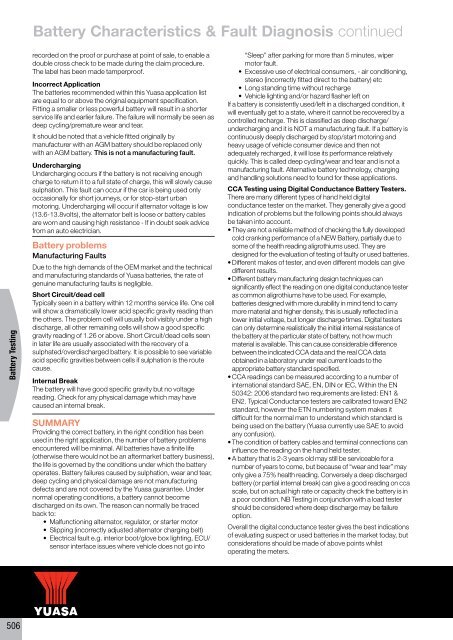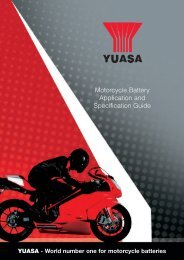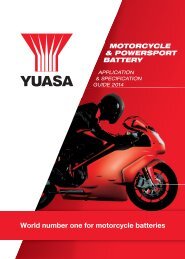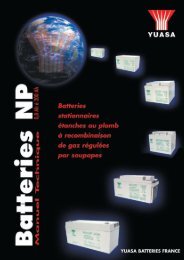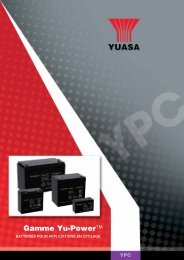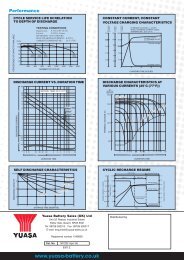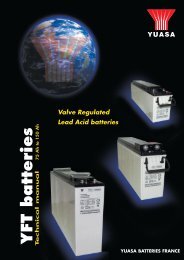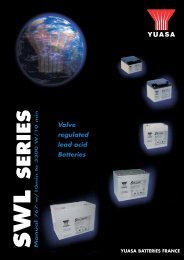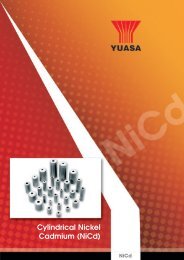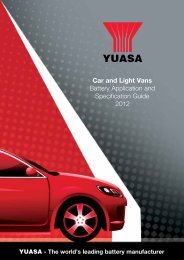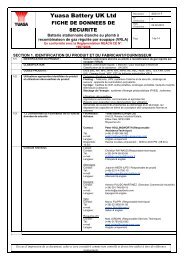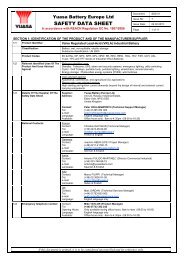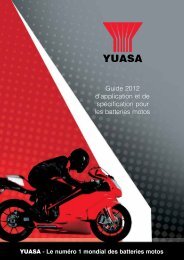to download CV, PSV, LCV, Agricultural & Plant Catalogue - Yuasa
to download CV, PSV, LCV, Agricultural & Plant Catalogue - Yuasa
to download CV, PSV, LCV, Agricultural & Plant Catalogue - Yuasa
- No tags were found...
You also want an ePaper? Increase the reach of your titles
YUMPU automatically turns print PDFs into web optimized ePapers that Google loves.
Battery Characteristics & Fault Diagnosis continuedBattery Testingrecorded on the proof or purchase at point of sale, <strong>to</strong> enable adouble cross check <strong>to</strong> be made during the claim procedure.The label has been made tamperproof.Incorrect ApplicationThe batteries recommended within this <strong>Yuasa</strong> application listare equal <strong>to</strong> or above the original equipment specification.Fitting a smaller or less powerful battery will result in a shorterservice life and earlier failure. The failure will normally be seen asdeep cycling/premature wear and tear.It should be noted that a vehicle fitted originally bymanufacturer with an AGM battery should be replaced onlywith an AGM battery. This is not a manufacturing fault.UnderchargingUndercharging occurs if the battery is not receiving enoughcharge <strong>to</strong> return it <strong>to</strong> a full state of charge, this will slowly causesulphation. This fault can occur if the car is being used onlyoccasionally for short journeys, or for s<strong>to</strong>p-start urbanmo<strong>to</strong>ring. Undercharging will occur if alterna<strong>to</strong>r voltage is low(13.6-13.8volts), the alterna<strong>to</strong>r belt is loose or battery cablesare worn and causing high resistance - If in doubt seek advicefrom an au<strong>to</strong> electrician.Battery problemsManufacturing FaultsDue <strong>to</strong> the high demands of the OEM market and the technicaland manufacturing standards of <strong>Yuasa</strong> batteries, the rate ofgenuine manufacturing faults is negligible.Short Circuit/dead cellTypically seen in a battery within 12 months service life. One cellwill show a dramatically lower acid specific gravity reading thanthe others. The problem cell will usually boil visibly under a highdischarge, all other remaining cells will show a good specificgravity reading of 1.26 or above. Short Circuit/dead cells seenin later life are usually associated with the recovery of asulphated/overdischarged battery. It is possible <strong>to</strong> see variableacid specific gravities between cells if sulphation is the routecause.Internal BreakThe battery will have good specific gravity but no voltagereading. Check for any physical damage which may havecaused an internal break.SUMMARYProviding the correct battery, in the right condition has beenused in the right application, the number of battery problemsencountered will be minimal. All batteries have a finite life(otherwise there would not be an aftermarket battery business),the life is governed by the conditions under which the batteryoperates. Battery failures caused by sulphation, wear and tear,deep cycling and physical damage are not manufacturingdefects and are not covered by the <strong>Yuasa</strong> guarantee. Undernormal operating conditions, a battery cannot becomedischarged on its own. The reason can normally be tracedback <strong>to</strong>:• Malfunctioning alterna<strong>to</strong>r, regula<strong>to</strong>r, or starter mo<strong>to</strong>r• Slipping (incorrectly adjusted alterna<strong>to</strong>r charging belt)• Electrical fault e.g. interior boot/glove box lighting, ECU/sensor interface issues where vehicle does not go in<strong>to</strong>“Sleep” after parking for more than 5 minutes, wipermo<strong>to</strong>r fault.• Excessive use of electrical consumers, - air conditioning,stereo (incorrectly fitted direct <strong>to</strong> the battery) etc• Long standing time without recharge• Vehicle lighting and/or hazard flasher left onIf a battery is consistently used/left in a discharged condition, itwill eventually get <strong>to</strong> a state, where it cannot be recovered by acontrolled recharge. This is classified as deep discharge/undercharging and it is NOT a manufacturing fault. If a battery iscontinuously deeply discharged by s<strong>to</strong>p/start mo<strong>to</strong>ring andheavy usage of vehicle consumer device and then notadequately recharged, it will lose its performance relativelyquickly. This is called deep cycling/wear and tear and is not amanufacturing fault. Alternative battery technology, chargingand handling solutions need <strong>to</strong> found for these applications.CCA Testing using Digital Conductance Battery Testers.There are many different types of hand held digitalconductance tester on the market. They generally give a goodindication of problems but the following points should alwaysbe taken in<strong>to</strong> account.• They are not a reliable method of checking the fully developedcold cranking performance of a NEW Battery, partially due <strong>to</strong>some of the health reading aligrothiums used. They aredesigned for the evaluation of testing of faulty or used batteries.• Different makes of tester, and even different models can givedifferent results.• Different battery manufacturing design techniques cansignificantly effect the reading on one digital conductance testeras common aligrothiums have <strong>to</strong> be used. For example,batteries designed with more durability in mind tend <strong>to</strong> carrymore material and higher density, this is usually reflected in alower initial voltage, but longer discharge times. Digital testerscan only determine realistically the initial internal resistance ofthe battery at the particular state of battery, not how muchmaterial is available. This can cause considerable differencebetween the indicated CCA data and the real CCA dataobtained in a labora<strong>to</strong>ry under real current loads <strong>to</strong> theappropriate battery standard specified.• CCA readings can be measured according <strong>to</strong> a number ofinternational standard SAE, EN, DIN or IEC, Within the EN50342: 2006 standard two requirements are listed: EN1 &EN2. Typical Conductance testers are calibrated <strong>to</strong>ward EN2standard, however the ETN numbering system makes itdifficult for the normal man <strong>to</strong> understand which standard isbeing used on the battery (<strong>Yuasa</strong> currently use SAE <strong>to</strong> avoidany confusion).• The condition of battery cables and terminal connections caninfluence the reading on the hand held tester.• A battery that is 2-3 years old may still be serviceable for anumber of years <strong>to</strong> come, but because of “wear and tear” mayonly give a 75% health reading. Conversely a deep dischargedbattery (or partial internal break) can give a good reading on ccascale, but on actual high rate or capacity check the battery is ina poor condition. NB Testing in conjunction with a load testershould be considered where deep discharge may be failureoption.Overall the digital conductance tester gives the best indicationsof evaluating suspect or used batteries in the market <strong>to</strong>day, butconsiderations should be made of above points whils<strong>to</strong>perating the meters.506


